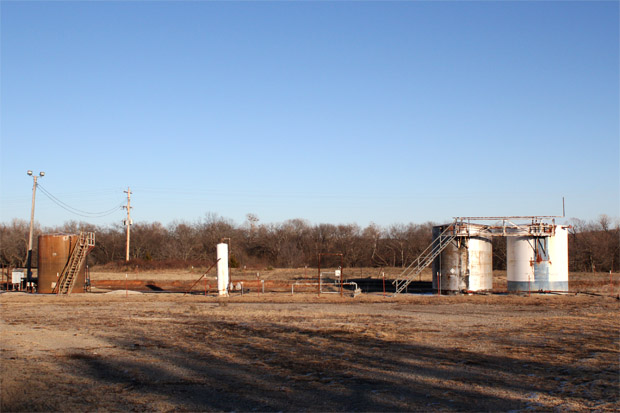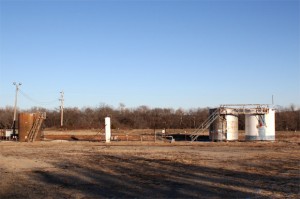
Seismologists say oil and natural gas disposal wells, like this one near Sparks, Okla., are likely triggering earthquakes in Oklahoma.
Joe Wertz / StateImpact Oklahoma


Seismologists say oil and natural gas disposal wells, like this one near Sparks, Okla., are likely triggering earthquakes in Oklahoma.
Joe Wertz / StateImpact Oklahoma

Joe Wertz / StateImpact Oklahoma
Some earthquake seismologists say oil and natural gas disposal wells, like this one near Sparks, Okla., are likely triggering earthquakes in Oklahoma and other states in the mid-continent.
Earthquakes have been increasing in Oklahoma and other states throughout the mid-continent, and many seismologists think this increased seismicity is linked to disposal wells used by the oil and gas industry.
The connection has caused oil and gas regulators in some states to re-evaluate how they issue permits for drilling. No such changes will be considered in Oklahoma until the state Geological Survey is more convinced of the link. The organization’s principal seismologist, Austin Holland, is a skeptic.
“In the United States, there are well over 100,000 disposal wells. And there are only a handful of examples that have been identified as induced seismicity,” he told StateImpact in January.
But the Geological Survey is installing new sensors to explore the link, the Journal Record’s Sarah Terry-Cobo reports.
Seismologists — even skeptics like Holland — agree that more information is needed to study disposal well-triggered earthquakes. But gaps in data stymie much of this research, and states don’t require well operators to record the type of data scientists say they need to understand the link.
Independent seismologists tell StateImpact they have a hard time convincing well operators — and their corporate legal departments — to provide additional data that could expose the companies to lawsuits and negative publicity.
One injection well operator that did agree to OGS monitoring ended up withdrawing from the project “due in part to unrelated costs and also to community protests,” the Journal reports.
But another company — which requested anonymity — has volunteered, according to the paper:
It will begin injecting saltwater into a rock formation called the Arbuckle Simpson in the next few months, Holland said.
The injection well will be monitored by seismic sensors placed northwest of Oklahoma City, the Journal reports:
The team will collect data daily on how the injected water moves underground, using sensitive instruments that measure gravity. As the water moves underground, the gravity measurements will change.
Holland’s team will combine the data with a computer model to predict where it will move. He said it is likely that there will be cases of induced seismicity, in which an earthquake is triggered. But drawing the conclusion that the injection wells caused the earthquakes is difficult, he said.
Editor’s note: A previous version of this post misidentified the location of the injection well. The injection well is operating in the Arbuckle Simpson formation in north-central Oklahoma, not the Arbuckle-Simpson Aquifer in south-central Oklahoma.